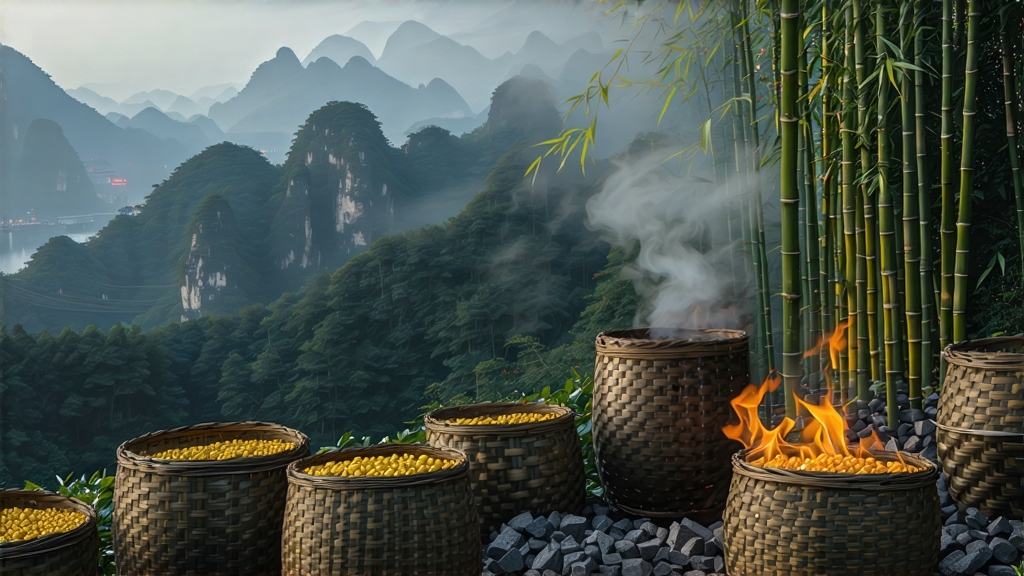
Tucked high in the mist-veiled Dabie Mountains of western Anhui Province, a tea so rare that even many Chinese connoisseurs have never tasted it quietly continues a 1 500-year dialogue between leaf, fire, and time. Huoshan Huangya—literally “Yellow Bud of Huoshan”—is the most aristocratic yet elusive member of China’s smallest tea family: yellow tea. Once reserved for Tang-dynasty emperors, later celebrated in Song-era poetry, and nearly lost during the turmoil of the twentieth century, this golden bud tea is today clawing its way back from oblivion, one hand-picked tip at a time. To understand Huoshan Huangya is to witness a living fossil of Chinese tea craftsmanship, a leaf that carries the perfume of mountain orchids, the sweetness of fresh corn silk, and the mineral echo of primordial granite soils.
History: From Tribute to Twilight
The first written record appears in the Tang dynasty (618-907) classic “The Classic of Tea” by Lu Yu, who lists Huoshan among the fourteen superior tea prefectures. During the Ming (1368-1644) the tea was pressed into cakes and shipped along the Han River to Beijing, entering the imperial palace through the Xuanwu Gate under heavy guard. Qing archives document 38 dan (roughly 2 300 kg) of Huoshan Huangya delivered annually to the Forbidden City, where the Qianlong Emperor famously compared its liquor to “liquid topaz that calms the dragon spirit.” The 1911 revolution ended the tribute system; Republican-era warlords requisitioned the gardens for opium poppies, and by the 1970s fewer than three mu (0.2 ha) of ancient seed-grown bushes remained. Revival began in 1985 when county agronomist Dai Zhaohui located 27 venerable mother trees in the Jinji Mountain Nature Reserve, using scions to re-establish 300 ha of gardens at 600–800 m elevation. In 2020 the European Union granted Huoshan Huangya Protected Geographical Indication status, opening a cautious but promising chapter for global aficionados.
Terroir: Where Granite Meets Cloud
Huoshan county lies on the northern edge of China’s subtropical zone, where cool air rolling off the Dabie massif collides with warm, humid currents from the Yangtze valley. The result is a 220-day fog season that filters sunlight into a soft, diffused glow ideal for the slow accumulation of amino acids. Soils are acidic granite derivatives, rich in potassium and magnesium yet strikingly low in calcium, a chemistry that translates into a naturally sweet, low-astringency cup. Day-night temperature differentials can exceed 15 °C in early April, encouraging the tea bushes (predominantly a small-leaf seed-propagated cultivar called “Huoshan Qixiang”) to synthesize fragrant terpenes at night while locking in sugars during cool, sunny days. The county’s bamboo forests also play a role: fallen leaves release coumaric acids that drift onto tea rows, subtly seasoning the leaf with a vanilla-like nuance.
Plucking: One Bud, One Standard
Authentic Huoshan Huangya is made only from the unopened bud and its immediately subtending leaf, plucked when the bud is still 15–20 mm long and sheathed in downy pale green scales. The picking window spans roughly ten days between Qingming and Grain Rain (early to mid-April), when the bud’s amino-to-polyphenol ratio reaches 0.38, the threshold for optimal sweetness. Experienced pickers use a “twist-lift” motion to snap the stem without fingernail bruising; the leaf must land in the bamboo basket convex-side up to prevent sunburn. A full kilogram of finished tea demands 42 000 such tips, the daily yield of a deft pair of hands working from dawn to dusk.
Craft: The Secret Art of Menhuang
Yellow tea’s defining process is menhuang—“sealing yellow”—a slow, oxidative smothering that falls between green tea’s kill-green arrest and white tea’s withered negligence. In Huoshan the choreography unfolds over five painstaking days:
- Sha-qing (kill-green): 180 °C drum roasting for 3 min 20 s reduces leaf moisture to 58 % and denatures polyphenol oxidase, but the operator stops short of the thorough dryness demanded